- Yellow Wattlebird
Taxobox
name = Yellow Wattlebird

status = LC | status_system = IUCN3.1
regnum =Animalia
phylum =Chordata
classis =Aves
ordo =Passeriformes
familia =Meliphagidae
genus = "Anthochaera "
species = "A. paradoxa"
binomial = "Anthochaera paradoxa"
binomial_authority = (Daudin, 1800)
synonyms = The Yellow Wattlebird ("Anthochaera paradoxa") is a species ofbird in theMeliphagidae family.9 Other names include the Long or Tasmanian Wattlebird.2Description
The yellow wattlebird is the largest of the honeyeaters5 and is endemic to Australia. They are usually 375-450mm long.2 They are named for the wattles in the corners of their mouths.2 Yellow wattlebirds are slim birds with a short, strong bill.7 They are dark coloured forest birds that somewhat resemble slandering Grackles.2 They have a white face and black streaked crown.5 They also have a long, pendulous yellow-orange wattle.5 The wattle becomes brighter during breeding.7 They have dark wings and a yellow belly5 whereas the upperparts are grey to dusky brown.2 The female yellow wattlebird is much smaller than the male.5 The young yellow wattlebirds have much smaller wattles, a paler head and a browner underbelly than the adult birds.7 Yellow wattlebirds are active and acrobatic with a strong flight.2 They are fairly tame birds and often enter gardens looking for food.2
imilar Species
The Little and Yellow Wattlebirds
Voice
Harsh, raucous, often been compared to a person coughing or vomiting2. Click the link to listen to the call of the yellow wattlebird [http://www.parks.tas.gov.au/wildlife/birds/yellow_wattlebird.AIFF] (Clip taken from Parks and Wildlife Service Tasmania)8
Breeding
Yellow wattlebirds nest in breeding pairs and aggressively defend their territories from other birds.7 The nest of the yellow wattlebird is made by the female alone7 and is a large, open saucer-shaped structure made of twigs and bark that are bound by wool.2 The inside of the nest is lined with wool and grass.2 The nests can be up to 13 cm high and are found in trees or shrubs2. Yellow wattlebirds lay 2-3 eggs that are salmon red, spotted and blotched red-brown, purplish red and blue-grey2. Both the males and females incubate the egg and feed the young7.
Habitat
Yellow wattlebirds live in a variety of habitats including both dry and wet forests and from sea level to the subalpine zone.7 They live in coastal heaths, forests and gardens near eucalyptus trees.5 They also can be found in mountain shrubberies and open woodlands, particularly those dominated with banksias.2 They have also been known to be found on golf courses, orchards, parks and gardens.2
tatus
Least concern
Range
Yellow wattlebirds are common in Tasmania especially in the eastern and central areas.7 They are also found on King Island and 2 sightings have been recorded on the South Mornington Peninsula in Victoria.2
Ecology
Yellow wattlebirds feed on the nectar of eucalypts and banksias, fruit, insects, spiders, honeydew and manna.6 They forage from all levels of the canopy from the ground to the top of the trees.7 However, the blossoming of eucalyptus trees can be highly irregular in time and place causing considerable changes from year to year in the breeding distribution of yellow wattlebirds which rely on the nectar from the eucalyptus trees as a main source of food4. Therefore, the most likely threat to the yellow wattlebird is unusual climatic conditions that can reduce food availability suddenly.6 Also, it is important to note that yellow wattlebirds have been found to be pollinators of eucalyptus trees by carrying pollen in both their bills and head feathers.1
References
* [http://www.environment.gov.au/biodiversity/threatened/publications/action/birds2000/pubs/yellow-wattlebird.pdf" The Action Plan for Australian Birds 2000: Recovery Outline – Yellow Wattlebird (King Island)" Australian Government Department of the Environment, Water, Heritage, and the Arts] Updated 27 Apr. 2008. Assessed 28 Apr. 2008
* [http://www.iucnredlist.org/search/details.php/50842/all Anthochaera paradoxa BirdLife International 2004]
*Hingston, Andrew B, Brett Gartell and Gina Pinchbeck (2004). “How specialized is the plant-pollinator association between Eucalyptus globulus ssp. Globulus and the swift parrot Lathamus discolour?” "Austral Ecology". 29(6), 624-630
*Pizzey, Graham. "A Field Guide to the Birds of Australia". Australia: Angus and Robertson, 1980
*Podulka, Sandy, Ronald W. Rohrbaugh and Nick Booney, ed." Handbook of Bird Ecology". 2nd ed. Ithaca: Cornell Lab of Ornithology, 2004
* [http://www.iucnredlist.org 2006 IUCN Red List of Threatened Species] Downloaded on 25 July 2007
*Ridpath, M. G. and R. E. Moreau (1966). "The Birds of Tasmania: Ecology and Evolution". IBIS, 108(3), 348-393
*Simpson, Ken and Nicolas Day. "Birds of Australia". 2nd ed. Princeton: Princeton University Press, 2004.
* [http://www.parks.tas.gov.au/wildlife/birds/yelwattle.html “Yellow Wattlebird, Anthochaera paradoxa.” Wildlife of Tasmania. Parks and Wildlife Service Tasmania] Updated 5 Mar. 2008. Assessed 25 Apr 2008
* [http://birdsinbackyards.net/finder/display.cfm?id=288 “Yellow Wattlebird" "Birds in Backyards"] Updated 11 Apr. 2006. Assessed 28 Apr. 2008
Wikimedia Foundation. 2010.
